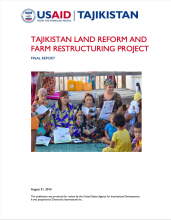/ library resources
Showing items 1 through 9 of 209.Return migrants play an increasingly important role in agricultural production in China and other developing countries. However, the effect of rural–urban migration experience on farmers’ arable land use remains unclear.
ABSTRACTED FROM INTRODUCTION: This brief has been developed by incorporating farmers’ perspective in relation to the Voluntary Guidelines on the Responsible Governance Tenure (VGGT) of Land, Fisheries and Forest Tenure in the National Food Security Context of Bangladesh.
This study examines the effect of land rights on agricultural outcomes in Rwanda. We characterize the effects of land rights from two perspectives. The first one is land rights indicated by the right to sell and guarantee land and the second one is land titling.
Like that in other post-communist states, Tajikistan’s agricultural decollectivization was initiated through top-down measures.
ABSTRACTED FROM EXECUTIVE SUMMARY: Throughout Tajikistan, land, and access to it, is paramount to continued resilience and improved livelihoods of rural citizens.
Although only 5 percent of Tajikistan's land area is farmable due to the country's mountainous geography, agriculture accounts for 53 percent of total employment. Among those households that engage in agriculture, almost 90 percent can be classified as small family farms.
An evaluation of headwater erosion and sediment dynamics was carried out to assess the health of the Middle Mountain agricultural system in Nepal.
Paginação
Land Library Search
Through our robust search engine, you can search for any item of the over 73,000 highly curated resources in the Land Library.
If you would like to find an overview of what is possible, feel free to peruse the Search Guide.









